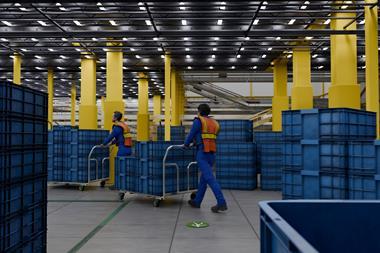Admit it. The words collaboration and suppliers in one sentence is enough to make retailers’ eyes glaze over. The concept is frequently bandied about, yet progress is painstakingly slow. However, although it doesn’t come naturally to retailers, open discussion throughout the supply chain can save both parties huge amounts of money and improve delivery performance at the same time.
Part of the problem, says Musgrave Budgens Londis supply chain director Scott Wharton, is that discussions about collaboration too often revolve around the IT issues. “That’s the reason everyone leans back in their chair and closes their ears. It’s usually because it’s an outside party coming to you and offering you a technology system to do it,” he says.
But the solution does not lie solely with a software provider. For collaboration to become a genuine priority, it comes down to implementing simple actions that drive discussion. “It’s about suppliers understanding the needs of the business they are dealing with and retailers being aware of where opportunities exist for their suppliers,” says Wharton.
Deepak Mishra, associate principal at consultancy McKinsey, which has researched how retailers and manufacturers can unlock savings in the supply chain, sums it up. “Retailers need to get more transparency into the process. Over the past few years, the relationship between the two has tended to be very combative, but that works against the process
of collaborative planning. To get to the next level of growth, you need transparency all the way,” he says.
As LCP Consulting chairman and founder Alan Braithwaite explains: “If the supplier can understand how to respond better to the retailer, they can decrease costs and, if they do that, they can potentially lower their margin, meaning retailers will build volume.”
Wharton joined Musgrave six months ago from Tesco. Since assuming the role, he has initiated review meetings with the company’s top 50 suppliers to listen to their issues and vice versa. “We’ve all been really honest, because we realise that working together is the route to being successful,” he says.
Troy Warfield, UK and Ireland managing director of Kimberly-Clark, supplier of tissue products such as Andrex, says collaboration is a “huge part of our overall strategy to become an indispensable partner to our retail customers”. He adds: “This begins with delivering our product on time and correctly invoiced, and goes right through to ways we can help save them money – and save ourselves money at the same time.”
Kimberly-Clark director of European supply chain Peter Surtees says that one simple way in which working together has reduced costs for both itself and its retail customers is by introducing another layer to its pallet units and stacking them more efficiently. It sells 20 million cases of Andrex a year on 850,000 pallets, which equals almost 17,000 full trucks a year. These efficiency measures have reduced the number of vehicles making deliveries by about 6 per cent – and anything that reduces deliveries reduces costs.
“If we have fewer trucks on the road then, inevitably, the retailer does as well when they’re moving our product from their central distribution centres out to their stores,” says Surtees. One of its retail customers even increased the height of its doors to make delivery of the higher pallet units easier.
A major supply chain problem that affects cost is forecasting capabilities – or, rather, a lack of them. Overestimating forecasts sometimes means that retailers try to back out of the supplier delivery, which has an impact on stock-holding. Underestimating means that retailers’ sales take a direct hit – another reason why sharing information is vital.
Ultimate Products head of supply chain David Bloomfield says that some of its retail customers share their shopping data on a weekly basis, which means they are better able to anticipate demand. But, equally, says Braithwaite, some retailers provide such information to no avail. “They despair because there’s no evidence that some suppliers are using it in a structured way,” he says.
McKinsey principal Christoph Glatzel says: “When it comes to missed orders, the cost of poor forecasting across the whole supply chain is huge.” Jon Blows, chief executive of digital goods supplier Catalus, agrees that it causes one of the biggest headaches for suppliers. “In some big retail organisations, the left hand often doesn’t know what the right hand is doing. For example, the marketing team may know about a promotion, but the buying team will have no idea,” he says.
Late orders and last-minute changes could be even more problematic this Christmas, because some suppliers are foreseeing major problems shipping goods from China – an ever-increasing amount of global sourcing means that freight space in Shanghai will be in very limited supply. Aside from more expense for the supplier, this could mean longer lead times for the retailer.
As DSGi supply chain director Jeremy Ross explains: “This summer, because of the bad weather, we have lots of air-con units left, but there’s now a huge shortage of tumble-dryers, which proves the point that forecasting isn’t, inherently, an exact science.”
However, with a spirit of openness, problems can be overcome. “When you have a good relationship with your suppliers, you have the flexibility to re-order,” he says. “We work with them to understand their supply chain and costs, and to look at how we can move stock through.” As a case in point, Curry’s has been working closely with Samsung to improve forecasting and the end result has been far greater efficiency (see box).
Another method of reducing costs is for retailers and suppliers to enter into a logistics agreement – something that McKinsey argues not enough retailers and manufacturers are doing. Under such an arrangement, suppliers offer their retail customers incentives for adopting supply chain practices that lower the cost of delivery. In other words, they receive specific discounts for placing efficient orders, such as a full truckload of goods instead of a partial load. This way, both sides can win: the retailer lowers its costs and the manufacturer, in turn, maximises the cost of shipping and delivery.
Braithwaite agrees that discounts can work, but warns retailers to exercise caution and consider them on a case-by-case basis. “It’s a trade-off. If you accept more goods, you need more storage capacity, which means you need bigger distribution centres, which means your stock rotation declines. Suppliers may offer terms for full truckloads, but retailers have to understand the complications.”
Supply chain financing solutions are another way of potentially improving working relationships and reducing costs. To meet the demanding payment terms set by their retail customers, global suppliers often have to borrow money locally at a high cost. But, with finance arrangements, suppliers can get cash at a lower cost, which benefits both them and the retailer.
ABN Amro head of global trade for transaction banking Adnan Ghani says that the company works closely with a clothing retailer with developing markets in Turkey. Borrowing money locally would have been hugely expensive, owing to high inflation, but, by providing cheap financing to suppliers, the retailer could procure goods at a lower cost and benefit from a higher profit margin.
Wharton says: “I can’t tell you the number of times I’ve heard that attitudes towards collaboration are changing.” But, he adds, the trust required isn’t always there. “Some suppliers automatically assume that collaborating means it’s going to come down to cost price, rather than improving on-shelf availability,” he explains. It may be difficult to achieve, but to give themselves the competitive edge, there may be no option but to bite the bullet.
Team players
Case study: Currys and Samsung
Currys and supplier Samsung wanted a more efficient working model to ensure the right product was available and delivered to the customer at the right time. It started discussions to map both supply chains in detail and its new system has been running for a couple of months.
Integrated supply chain IT networks and daily updated information are now available to Currys, Samsung and the factory, and a conference-call cycle has been set up. This includes one call to share forecasting and one to share the intake plan, which will have been modified as a result of the first call.
The changes have clearly resulted in greater efficiency. “Sales forecasting errors are down by 50 per cent and, 19 times in 20 that a customer visits a store, they will find a product to buy and take away there and then,” says DSGi buying director for vision products Phil Samuels. He adds that there is a “close to 0 per cent failure rate” in delivering the products it is asked to in the week they are requested.
Case study: Sit-up TV and Ultimate Products
Ultimate Products is one supplier that operates a full-service approach with the majority of its retail customers. It decides with buyers exactly what will sell in particular stores during key buying periods, then designs, manufactures and packages the products before delivering them when they are needed in-store.
Constant collaboration between the two has meant everything runs according to the “critical path”, says Ultimate Products head of supply chain David Bloomfield. This includes joint meetings at manufacturing sites to ensure factory assessments and booking processes are optimal.
“It’s almost like going through a logistics sign-off with them,” he says. “That gives them confidence that we’re going to do what we say we’re going to do.” In turn, it enables the supplier to get a good price for the cost of the products and offer a competitive price to the retailer.


























No comments yet